Can You House Female and Male Baby Tegus Together
Despite the name, the Argentine Tegu tin be found in multiple places across South America: Brazil, Paraguay, Uruguay and Argentina.
The Argentine Black and White Tegu is as well known equally the Argentine Behemothic equally they grow upward to 4.5 feet long, weigh twenty pounds and are typically black and white in colour.
Their behemothic-size can easily trick reptile enthusiasts into believing they are dangerous. Even so, they are known to be very docile.
In general, they are known to develop a close human relationship with their owners; some fifty-fifty compare them to beingness similar to companion pets. And to this their charm, and ease-of husbandry, it'south easy to run across why they are becoming popular reptiles.
Go on on reading our complete intendance canvass to learn more almost their muzzle requirements, diet-blazon, typical beliefs and where to find reputable breeders.
Tabular array of Contents
- What Is An Argentine Tegu?
- Argentine Tegu Care Guide
- Tank and Enclosure
- Feeding An Argentine Tegu
- How To Keep Them Good for you
- Are Argentine Tegus Aggressive?
- Can Tegus Exist Kept Together?
- Argentine Black and White Tegu Appearance
- Infant Argentine Tegus
- How Much Do Argentine Tegus Cost?
- Care Guide Summary
What Is An Argentine Tegu?
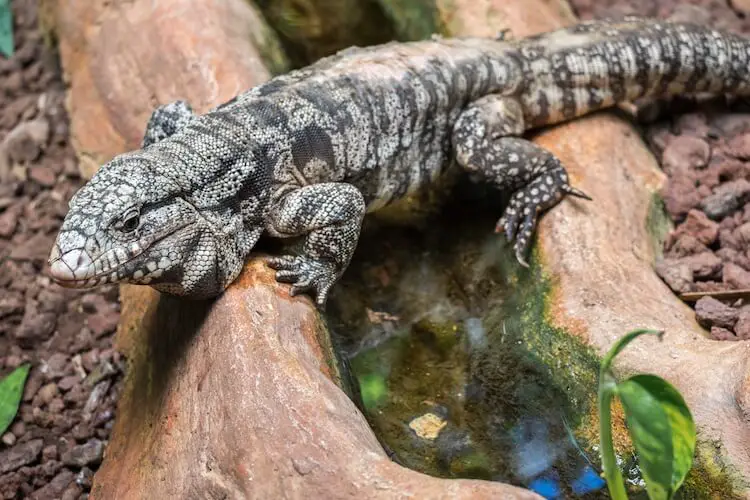
Tegus are a grouping of lizards that have a similar physical clarification, however, some are slightly smaller and can come up in different color variations (e.m. red, black and white).
Argentine Tegus are native lizards to eastern and central South America. They are a product of convergent evolution and live in tropical rainforests, deserts and savannas.
Due to irresponsible owners freeing their captive lizards into the wild, some Blackness and White Tegus accept been reported equally far away as Florida.
The Argentine Black and White Tegu is very long, sometimes measuring five feet in length, and they have a robust, stocky build with long tails and powerful legs, giving them the power to run very fast.
Their beaded skin is made up of black and white dots and stripes, yet, their most unique feature is their "stubby cheeks". This feature can just be seen in males and information technology is considering of sexual choice (i.due east. stronger jowls equate a stronger male person).
This lizard is popular for two unfortunate reasons:
- They are a nutrient delicacy
- They are used to make leather
However, there are many reasons why people love having this Behemothic Tegus every bit pets. They're very bonny, smart, and calm. These lizards are i of the most affectionate reptile-species in captivity.
They plant a shut bond with their owners, because of this, many Argentine Tegu owners compared owning one to owning a canis familiaris or cat, some other reason why they're and then popular!
Mostly active during the twenty-four hours, they like to spend their time basking or looking for food, they are as well known for having a calm and affectionate temperament making them great for handling.
| Summary Table | |
|---|---|
| Mutual Names | Argentine Giant Tegu, Black and White Tegu |
| Scientific Proper name | Salvator Merianae |
| Adult Size | 3 to five feet long and 20 pounds |
| Lifespan | fifteen-20 years |
| Diet | Fruit, insects, and lean meat |
| Tank Size | Minimum of 8 past 4 past four feet |
| Humidity & Temperature | 75-85°F and humidity should be kept between 75-90% |
| Popular Alternatives | Cerise Tegu |
Argentine Tegu Care Guide
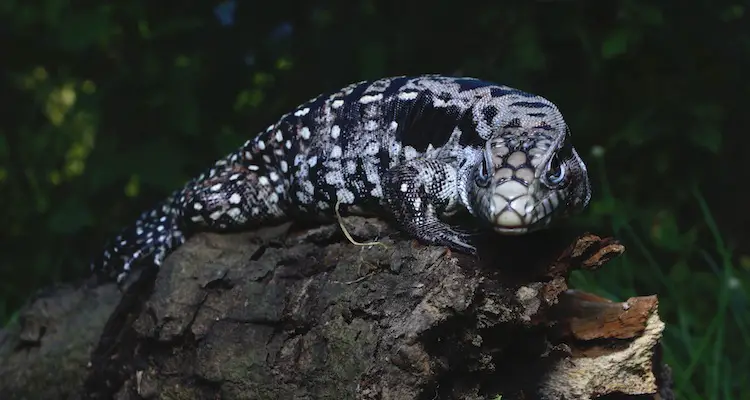
Outside of captivity, Argentine Tegus are found in the tropical areas of eastern and primal South America. They are able to climb merely prefer to stay closer to the ground (i.e. terrestrial) and may besides be found swimming in freshwater.
Because the Argentine Tegu thrives in warm temperatures, in captivity they crave an even-hotter basking spot (more on this below)!
Tank and Enclosure
Since they are very big lizards, they demand a tank with plenty room to fit their long tail. The best enclosures for Argentine Tegus are constructed out of melamine with ane glass window in guild to observe your pet.
Because of this cadger's fast growth rate, and giant-adult size, information technology is okay to use an adult tank from the start however some owners choose to first with smaller cages:
- Hatchlings can be housed in 20-gallon terrariums.
- Juveniles tin be housed in 80-gallon terrariums.
- As they grow, adults should live in a terrarium that is at least 8 x 4 10 four feet.
Generally, females aren't every bit long as males so their tank tin can be slightly smaller, but be sure to go along in mind that Tegus are active lizards and they should have a minimum muzzle size of viii x 4 x 4 feet.
Lighting
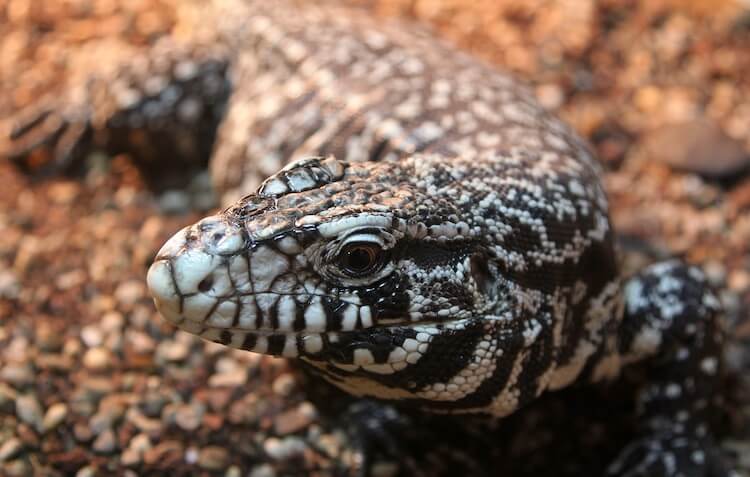
The Argentine Blackness and White Tegu requires UVB lighting to be healthy in captivity. Terrarium hoods that tin support this type of lighting tin exist establish very easily.
This type of Tegu too requires a very hot basking spot which can be achieved through ruby rut bulbs. A very hot basking spot of 100-110 degrees Fahrenheit should exist available at all times. In the wild, Tegus spend a lot of time basking under the sunday, so it is important to simulate this in their tank.
A right enclosure should include a heat gradient. The basking spot should be the hottest area in the enclosure at 100-110 degrees Fahrenheit and the cooler-spot (on the opposite side) should stay betwixt 75-fourscore degrees Fahrenheit.
Red bulbs, heat pads and ceramic heat emitters can all work to keep your tank overnice and warm.
The correct humidity level is betwixt 75-90%. This can exist accomplished by mixing water into the substrate until it is clammy or with a spray bottle.
Substrate
Considering Argentine Tegus love to burrow, they are going to take to alive in lots of substrate.
Substrates made out of cypress mulch, coconut coir, sand or soil are the best because they will retain moisture which helps to go along the humidity high.
These reptiles love to burrow so hatchlings volition demand nearly a substrate depth of 4 inches and adults will need viii inches. Substrates that are dusty or resinous should be avoided at all costs because they are toxic to Argentine Tegus.
They should also accept a water dish large enough for them to climb into and soak. Any other decorations should exist sturdy enough to support this cadger'due south weight.
| Tank Tips | |
|---|---|
| Tank Blazon | Melamine |
| Lighting | UVB light and red-bulb for basking spot |
| Best Substrate | Cypress mulch or coconut coir |
Feeding An Argentine Tegu
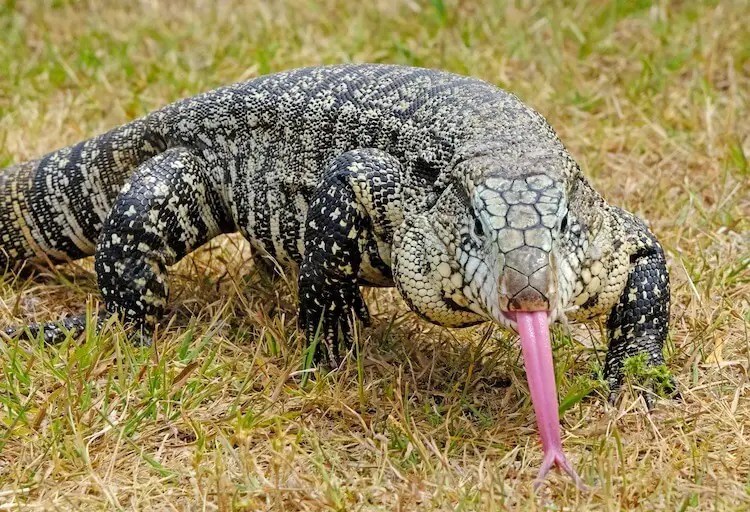
Like all reptiles, a healthy diet and a comfortable environs are cardinal. Tegus tin be considered opportunistic omnivores, meaning that they volition eat whatever is bachelor to them. In captivity a healthy nutrition should include: insects, fruit and meat. They are omnivores, making their diet easy to care for:
- Adults should be fed every three days
- Juveniles volition need to eat every other day
- Younger hatchlings require being fed more than ofttimes and will demand to swallow every 24-hour interval
For a balanced-diet, you lot should feed your lizard lean meats or other sources of poly peptide such as egg or fish. They volition also eat frozen rodents, fruit and vegetation. Baby Tegus tin eat insects as long as they're dusted in calcium pulverization.
Sectional prey diets are not recommended for the Argentine Tegu because they might not obtain plenty nutrients. They should be eating vegetation and fruit too. Left-over food should be removed after every meal.
Your Tegu's tank should always have a dish of fresh and clean h2o. In addition to having a h2o dish, you may also want to provide a larger h2o container and so your Tegu can soak in it. This will help forestall aridity, aide in shedding and go on the proper humidity levels.
| Diet Summary | |
|---|---|
| Fruits | 30% of diet |
| Insects | x% of diet |
| Lean meat | 60% of diet |
| Supplements Required | Calcium |
How To Keep Them Healthy
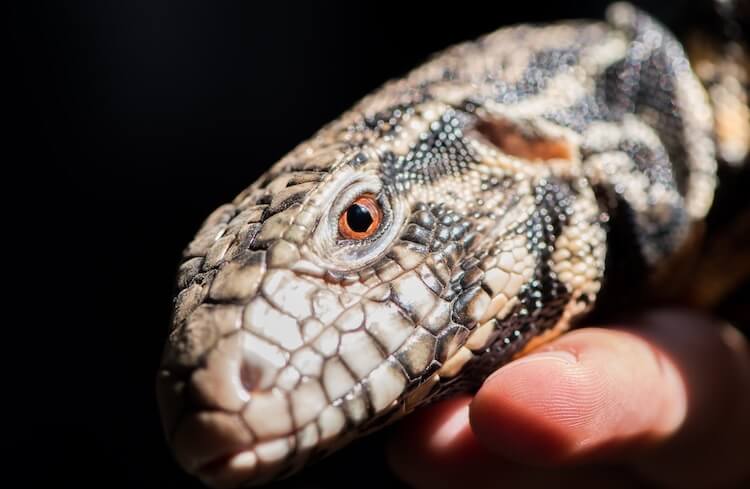
Tegus may harbor salmonella then you must wash your hands earlier and subsequently handling.
Argentine Tegus have a reputation for being docile and calm. Simply like all lizards, they must become comfortable with you first before handling. If not, their flight-or-fight tendencies will boot in.
Adults volition exist more difficult in domesticating, so you should admittedly start handling these reptiles when they're young. Hatchlings are as well less likely to seize with teeth; they might try to run away instead.
They should be handled frequently so they tin can learn to trust you. Argentine Blackness and White Tegus tend to be nutrient aggressive, so you should just try handling when there is no food in the cage.
You may stroke and pet them while they eat, but feeding them off of your hand is not recommended. Somewhen y'all will observe that your lizard will kickoff coming to you instead of the other way around.
Bathing
Some lizards struggle to shed. Withal, the Argentine Tegu doesn't demand to breast-stroke as the humidity levels in their tank should exist enough for their skin to shed properly.
However, providing a tub of water large enough so your Tegu can soak won't do whatsoever damage. If y'all do decide to do this, make sure you never exit it unattended and the water should not go past your Tegu'south shoulders.
Tank Cleaning
Faster spot-cleans should exist undertaken daily. The enclosure should be misted a couple of times a day, either by manus or an automatic mister.
Their waste should be cleaned daily with your daily spot-cleaning.
Healthy waste is brown and is firm. It may exist runnier if they just ate fruit. In that location may be a white or yellowish substance that follows the stool which is fabricated upwardly of uric acid. If you discover that their stool is continuously runny, you lot should talk them to a vet for this may exist a sign of internal parasites.
Deep cleaning the cage, food and water bowl(s) should be a monthly routine. You should employ a 1:10 dilution of bleach equally long equally your Tegu isn't inside the cage.
| Signs They Are Healthy | Sickness Symptoms |
|---|---|
| Clear optics, nose and vent | Twitching (symptom of Metabolic Bone Disease) |
| Eats frequently | Loss of appetite |
| Active | Languor |
How Long Do Argentine Tegus Live?
In captivity, Argentine Black and White Tegus can alive from 15 to 20 years.
The most common wellness concerns for this species is metabolic bone illness, calcium or phosphorous deficiency, salmonella and internal parasites. About, if not all, of these health issues arise in the presence of an unhealthy diet or improper temperature and humidity levels.
In cooler months, y'all may notice your Tegu is very inactive and lethargic. This is completely normal! Because they come from hot climates, Argentine Tegus tend to brumate during the colder season.
Are Argentine Tegus Aggressive?
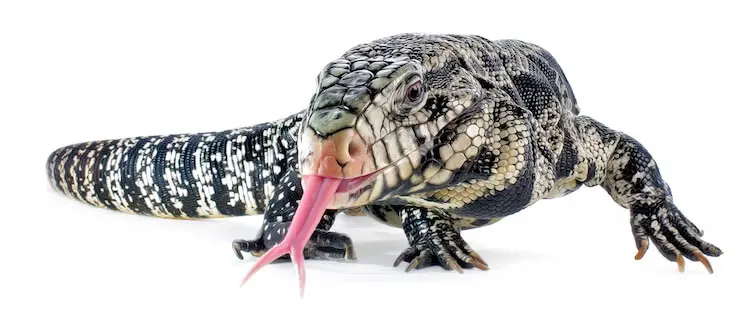
In the wild, these reptiles are establish on the ground, either basking or looking for food to swallow. They are mostly agile during the day and are establish lone. Wild Tegus are more than ambitious than captives and will scare off predators by running on their hind anxiety or huffing.
Argentine Tegu is very hostile when it comes to their food and would near definitely engage in fights considering of it.
They will communicate my making huffing noises if they're irritated. If they arch their backs, this might hateful that they are hostile and ready to attack.
In tanks, yous may discover your cadger volition nod their heads like Iguanas. They will spend nearly of their time in the basking spot and enjoy burrowing into their substrate and hiding.
If you allow them out of the cage, they may seek out human attention and like to explore around.
Argentine Tegus are very friendly and intelligent, they are able to recognize their owners and make a connection with them. This is only true for lizards who accept been handled since they were hatchlings.
Can Tegus Be Kept Together?
Argentine Tegus are able to share their living area. If you lot are keeping ii or three, you will demand a bigger muzzle with more hiding holes.
Just to be safe, make certain you are closely observing your lizards to avoid fighting, especially during feeding time.
Argentine Black and White Tegu Advent
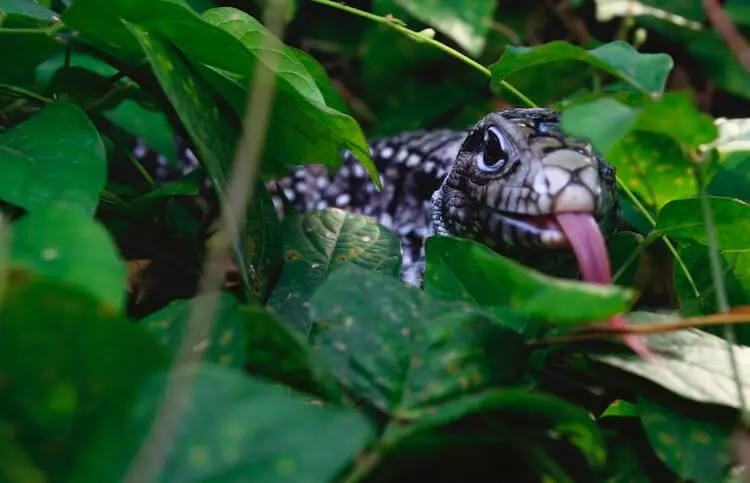
Differentiating between female and male Argentine Black and White Tegu is very easy. Females will be shorter than males (growing upward to three feet) and males are typically 4.v feet (1.5 feet longer):
- Male person lizards can grow upwards to 4.5 feet long and weigh 20 pounds
- Females will be 3 feet and weigh virtually xv pounds
Males also tend to have bigger jowls which gives them the appearance of "stubby cheeks"
Every bit hatchlings, Argentine Tegus volition be about vii-x inches long. They tend to have a very fast growth rate, reaching about 75% of their last length in just 1 year.
The beaded skin of an Argentine Tegu will ever be blackness and white. They volition take many bands and stripes. As hatchlings, they might take green on their heads (reaching downwardly to their necks); this color fades away within a few months and turns into black and white.
They can come up in red, making them the Ruddy Tegu. They are much like the Argentine but may be slightly smaller.
Infant Argentine Tegus
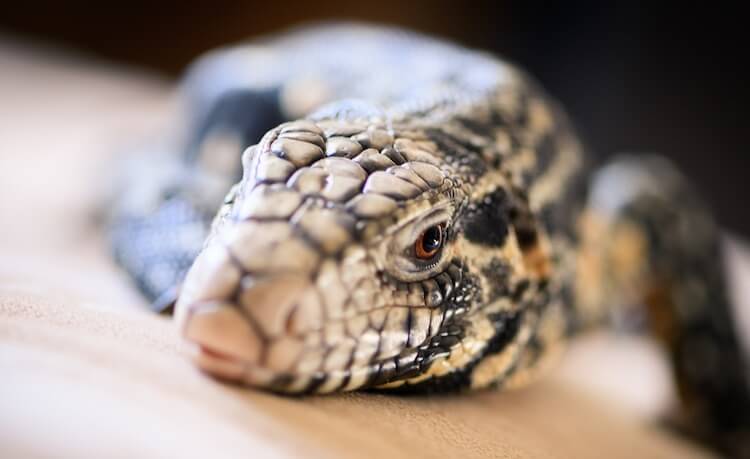
Argentine Tegus are sexually dimorphic, making it like shooting fish in a barrel to distinguish male from female.
When trying to attract females, males will often make popping noises and shake their heads. Females may outset swaying dorsum and forth or drag the back of their bodies.
Copulation volition take place for 1-2 weeks and eggs will hatch in well-nigh 58-60 days. Females can lay anywhere from x to 73 eggs in one clutch, though the average is 30.
The all-time incubation temperature is between 86-90 degrees Fahrenheit. Hotter temperatures may crusade the babies to hatch ahead of fourth dimension meaning they won't exist as healthy.
Hatchlings will need to exist fed every twenty-four hours. They are by and large insectivorous and can be fed medium-sizde crickets, Dubia roaches, mealworms and earthworms. Hatchlings should be handled often at this point so they can abound up to be docile.
How Much Do Argentine Tegus Cost?
Argentine Tegus retail for about $200 USD. They can be found through many breeders, so it is important that you find a reputable breeder for a healthy lizard.
Intendance Guide Summary
Argentine Tegus may be a little intimidating to some amateur enthusiasts. If you are still unsure, merely know you want to accept on such a giant lizard, you can besides await at the Blood-red Tegu.
In order to successfully keep an Argentine Black and White Tegu, you must exist able to give them a proper environment to alive in. This ways:
- Space (their enclosures are not small)
- Right diet with lots of lean meat
- A tank that closely replicates their natural environment
Higher up all, your Tegu will need a lot of dear. They are fantastic pets for people who seek companionship and are willing to put in the effort.
If yous're looking for a reptile that can provide y'all a rewarding relationship, y'all might have simply come across your platonic pet. Argentine Tegus are one of the smartest, most affectionate reptiles out in that location.
Source: https://www.everythingreptiles.com/argentine-tegu/
0 Response to "Can You House Female and Male Baby Tegus Together"
Post a Comment